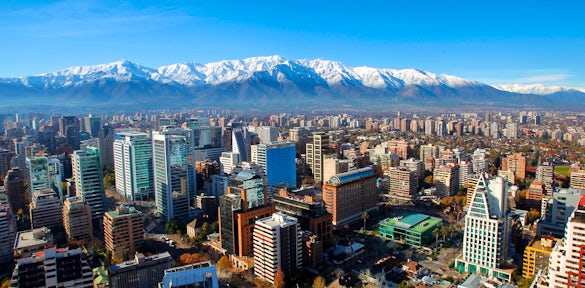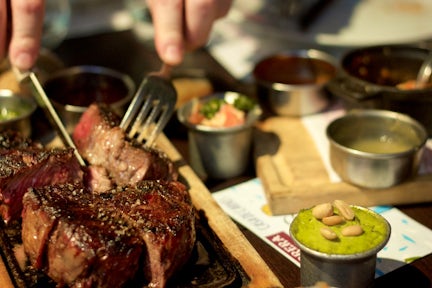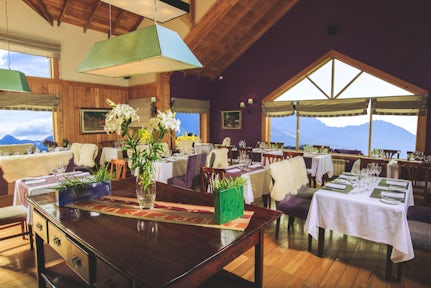Latest Update: The Argentine Economy
Before you dive into our guide, we wanted to let you know that Argentina elected a new government in December 2023, which resulted in some changes to the economy. Prices across various industries and services have been fluctuating and foreign exchange rates are more variable than usual. This will likely continue to be the case throughout 2024 as new legislation is rolled out.
If you will be travelling through Argentina en route to Antarctica, we recommend that you check the 'blue dollar rate' ('Dólar Blue') and official exchange rates ('Dólar Oficial') before travelling to depart feeling as prepared as possible.
At present, foreign-issued credit cards represent the best and safest way to budget and pay for most of your travel costs.
Money
When passing through Chile/Argentina on your trip, we recommend the following:
- When taking US dollars with you in cash, make sure you bring a mixture of denominations, but be aware that larger bills will get a better rate of exchange. Small bills are useful for tipping.
- In Chile, most spending can be done with a credit card. Many places will also accept credit cards in Argentina. Paying with a debit or credit card usually results in a favourable exchange rate.
- Take two credit or debit cards with you (in case one doesn’t work) to withdraw local currency from ATMs and for paying in restaurants; Visa, Mastercard and Amex are widely accepted. Please be aware that you may be charged high fees every time you use an ATM or pay with a card, so do check with your bank before travelling. ATMs will only expend local currency.
- Chilean and Argentinian pesos are not considered major currencies, so banks and foreign exchange companies in your home country are unlikely to have a readily available supply. This is why it is a good idea to travel with US dollars to either spend as US dollars or exchange into local currency. After returning home you may find it difficult to trade in any excess pesos you may have.
- In Argentina, US dollars are generally accepted in tourist areas but are not legal tender or widely accepted in the rest of the country.
- Traveller's cheques are not advised for either country as they are very hard to change and given a low rate.
- For the best taxi fares at Santiago or Buenos Aires airport, book through the official desks or in advance to avoid scams and get transparent pricing.
Currency options
Argentina

- The official currency of Argentina is the Argentine Peso ($). However, it's common to use US dollars in tourist areas, and most hotels and restaurants used to dealing with international travellers will accept them. We recommend checking if US dollars are accepted before ordering anything. GBP and EUR are not widely accepted.
- As foreign currency is not generally accepted outside of establishments catering to tourists, you will need to carry a small number of pesos for paying taxis, museums, supermarkets and so on, or use a credit or debit card.
- If given the choice when paying by card to select either USD or Argentine Pesos, choose the local currency option (AR$) as this will give you the most beneficial exchange rate.
- Major credit cards are widely accepted in the main tourist areas and cities, and ATMs are prevalent, but please note that there may be a relatively low cap on the maximum withdrawal limit.
- You can access funds via 'casas de cambio' (money exchange booths). Ask your hotel for recommendations on where to exchange money.
- Do not exchange money with anyone on the street – fake notes are often used. You can see all legal Argentine Peso tender notes on the Central Bank of Argentina’s official website.
If you would like to understand more about the Argentine economy, both its history and the current situation, we recommend reading this article written by Swoop's Product & Partnerships Manager, David.
David is half Argentine and has spent many years living in and exploring Argentina.

Argentine pesos

Swoop says
Be aware that both the Chilean and Argentine Peso symbol is $, which is not to be confused with the $ symbol for the United States dollar – don't get caught out!
Chile
- Chile's official currency is the Chilean Peso ($). In contrast to Argentina, US dollars are rarely used day to day when paying for things but are easy to exchange during office hours (9am-6pm). Some hotels may exchange USD for pesos in an emergency, but we wouldn’t recommend you rely on this.
- Credit and debit cards are widely accepted throughout Chile. You can also easily withdraw cash from an ATM, although they are harder to find in remote areas, so we advise stocking up in a city or town in advance.
- Chile does not have a significant black market for foreign currency, so you’ll largely find the same rate being applied throughout the country.
- You can see all legal Chilean peso tender notes on the Central Bank of Chile’s official website.


Swoop says
Argentina currently has a black market (known as the 'blue' market) for foreign currency, so travelling with and spending US dollars in cash is recommended as they are widely accepted in tourist areas. This is an accepted way of life here, so don’t worry, you’re not doing anything illegal. Most establishments (cafes, bars, restaurants and tour operators) will accept US dollars in cash at a slightly better rate than when using credit cards, but the actual exchange rates will vary greatly. You may save anywhere from 5-50% over the official rate of exchange. Always ask what the rate of exchange is before purchasing.
Budgeting
While in Argentina, a rough budget of $30-60 USD per person per day for lunch and dinner may be helpful.
In Chile, $40-80 USD per person per day should suffice. However, this will obviously depend on where you choose to eat.

Tipping
Tipping in Argentina & Chile

Argentina, particularly, is a very tipping-oriented country, like the US. Tips are expected, so keep a stock of small-denomination notes handy.
In Chile, tipping isn’t quite as prevalent, but it's very much appreciated, and is certainly expected in restaurants.
Tipping taxi drivers is not customary in Chile or Argentina and is at your discretion. Keep in mind that city cab prices are always charged in the local currency.
Tipping about 10% is standard in restaurants in both Chile and Argentina, but is not obligatory and is not added automatically to your bill. A service charge may be added in some places, which is separate from the tip and is used to cover complimentary entrees which may be served. While some establishments will be able to add a tip to your credit card charge, this is not always possible, so consider leaving a tip in cash, at your discretion.
Generally, we suggest the following guidelines:
- Hotels: $20 USD per person, per day – given at the end of your stay at an all-inclusive hotel
- Meals: 10% of your bill – sometimes restaurants will charge you a modest ‘cubierto’ fee, this is not the tip for your waiter, but a cover charge for bread and nibbles. Tips at restaurants cannot usually be charged to your card so should be left in cash.
If you are staying at hotels in Chile or Argentina before or after your cruise, it may also be helpful to note:
- Sometimes you can tip via the front desk at the end of your stay at a hotel for everything, sometimes you might be expected to tip the hotel restaurant staff separately. It is worth asking before your stay.
- Each hotel is likely to have a different physical approach to actually tipping – sometimes you leave cash in an envelope, and other times it can be charged onto a credit card. Again, ask the hotel how they do it.
Tipping on board your ship
Tips are not generally included in your cruise fare (some exceptions apply on the all-inclusive ships) so if you would like to tip the crew an approximate suggestion would be $10-20 USD per passenger per day on board. Your ship may provide its own guidelines on board.
It's very much at your discretion, however, the tips are generally divided up between the crew, including the wonderful but sometimes unseen housekeeping staff, as well as the restaurant and bar team. It is not expected that you would tip staff individually.
Tips are usually collected just prior to the end of the cruise and can usually be paid on a credit card when you are settling up your tab.











